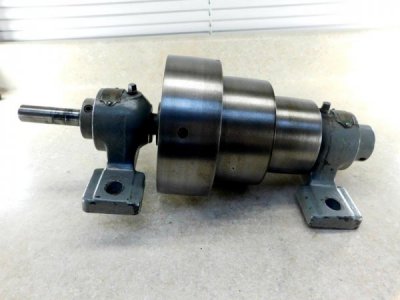- Joined
- Jan 3, 2013
- Messages
- 78
The .0005 clearance is perfect for bronze and babbitt bearings. When reassembling hopefully cleanliness was the order of the day.
Earlier in your series I see photos of Gits Oilers on the lathe, these are excellent. Set to dispense 2 drops a minute at first.
I don't recall seeing any pics of the bearing caps. Oil distribution is the next hurtle, on my old lathe I filed a .020 X 45 chamfer at the bearing split line
starting 3/16 inch from one end and stopping the same amount from the other. This was accomplished with a smoothing file working from
the inside towards the outside to direct any burrs out. Both bearing halves front and back received this treatment.
This makes an oil reservoir front and back to bathe the spindle.
To get the oil to the reservoir, I took the cap to the bench vise and clamped on the cast iron. Using a sharpie I drew an X, from the end of one chamfer to the
opposite end on the other side, intersecting at the oil hole. Using a vitrified cutoff wheel 1 inch dia. by .04 thick in a die grinder, an oil grove was cut approx. .020 deep
following the drawn X. A similar X was drawn on the lower bearing half and oil grooves cut. Deburring was accomplished with a small bearing scraper.
Everything was cleaned and oiled prior to reassembly.
My lathe runs great now that enough oil is applied to the correct areas.
Restorer
Earlier in your series I see photos of Gits Oilers on the lathe, these are excellent. Set to dispense 2 drops a minute at first.
I don't recall seeing any pics of the bearing caps. Oil distribution is the next hurtle, on my old lathe I filed a .020 X 45 chamfer at the bearing split line
starting 3/16 inch from one end and stopping the same amount from the other. This was accomplished with a smoothing file working from
the inside towards the outside to direct any burrs out. Both bearing halves front and back received this treatment.
This makes an oil reservoir front and back to bathe the spindle.
To get the oil to the reservoir, I took the cap to the bench vise and clamped on the cast iron. Using a sharpie I drew an X, from the end of one chamfer to the
opposite end on the other side, intersecting at the oil hole. Using a vitrified cutoff wheel 1 inch dia. by .04 thick in a die grinder, an oil grove was cut approx. .020 deep
following the drawn X. A similar X was drawn on the lower bearing half and oil grooves cut. Deburring was accomplished with a small bearing scraper.
Everything was cleaned and oiled prior to reassembly.
My lathe runs great now that enough oil is applied to the correct areas.
Restorer

